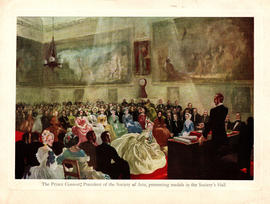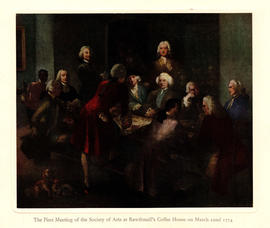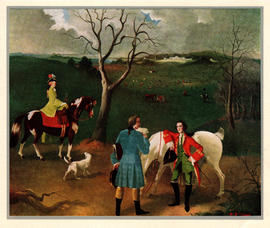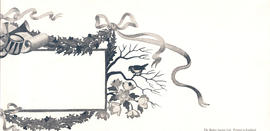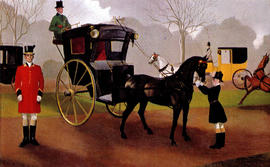Part of a set of six postcards featuring designs by members of the Faculty of Royal Designers for Industry
Part of a set of six postcards featuring designs by members of the Faculty of Royal Designers for Industry
Painted by Anna Zinkeisen, T R Crampton is third from left, wearing an Inverness cape. Awarded the Society's gold medal in 1846 for his invention of the narrow-gauge locomotive engine. Working from engravings and records preserved at the Science Museum and in the archives, the artist has reproduced not only the design but also the original colouring of the engine. 34,000 copies sold.
The first known Christmas card appeared in 1843. The artist was J C Horsley, RA, who carried out the work at the suggestion of Henry Cole, a staunch supporter of the Society and Chairman of Council in 1850 and 1852. 25,000 copies sold.
Some contain images and descriptions of the pictures
Original painting was awarded a prize of five guineas and a silver medal in 1759. The artist was 15 years old and the silver medal was given in addition to the advertised monetary prize 'as a further reward for her extraordinary merit'. Mary Moser was a founder member of the Royal Academy in 1768 and one of the first two women Academicians. 11,000 sold
Viscount Folkestone was the first President of the Society of Arts, 1755-1761. 13,000 sold
Designed by Miss Anna Zinkeisen, incorporates the features of five members whose portraits can now be traced as: Dr Stephen Hales (at far end of table), Henry Baker and Viscount Folkestone (both standing), Lord Romney and William Shipley (centre of table, far side). The others present at the meeting were John Goodchild, Gustavus Brander, James Short, Nicholas Crisp, Charles Lawrence and Husband Messiter. 22,500 copies sold.
Painted by Anna Zinkeisen. In 1758 the Society of Arts offered prizes for what were known as 'ship's blocks', i.e. scale models of ships, in order to 'ascertain by experiments the principles on which a good vessel is founded'. Water resistance and resistance to rolling were two of the main qualities it was desired to test. It was not until 1761 that sufficient models had been submitted for the prizes but that year six entries, 4 32-gun frigates and 2 74-gun ships, were tried at Peerless Pool, near Old Street, in the City of London. 26,500 copies sold.
24 members of the Society's Committee of Agriculture gathered in what was then the open countryside of Brompton, between Westminster and Kensington, to witness the performance of four newly invented seed drill. The Chairman of the Committee can be seen standing in the foreground with Joshua Steele, the celebrated writer on prosody, and Major General George Eliott. To the General's left is the Reverend Humphrey Gainsborough (a brother of Thomas), who looks toward the middle distance at the seed drill he has invented and for which the Society gave a prize of £30. The other successful machine, invented by James Willey appears prominently in the centre of the picture. It won its inventor a prize of £20. Willey stands talking to Joshua Steele and the General and pointing towards his drill. In the background can be seen the two unsuccessful drills, one of which was to be found to be 'capitally defiecient in some part' and the other to be too close to Jethro Tull's famous prototype. 27,000 copies sold.
William Shipley is shown selling winter fuel to the poor at summer prices in a street called the Drapery, in the centre of the town, where he had lodgings and a studio for his professional work as an artist and drawing master from 1747 until 1753. He is being assisted in his calculations by some of the richer Northampton residents who had, after some years' canvass, agreed to subscribe to his fund. The success of his scheme to defeat the Northampton fuel profiteers made Shipley persevere with his plan to raise a national fund for rewarding useful inventions and artistic excellence and in 1753 he came to London with the express purpose of founding a Society of Arts. 28,200 copies sold.
Alternative Christmas card, based on a plate from Volume XXIII of the Society's Transactions. 2,100 copies sold.
Illustrations of inventions are reproduced from drawings based on engravings which originally appeared in the Society's Transactions. 33,500 copies sold.
In 1872 the Society offered prizes for improvements in the design of London cabs. Many of the leading cab proprietors and builders of the day put forward their vehicles. These were submitted to extensive testing, including a journey in procession from Kensington to the City and back, by a special committee of the Society, which suggested detailed practical improvements to six of them. Eventually four of the improved cabs were awarded prizes of £30 each. The picture shows the scene in the grounds of Malborough House on 1st November 1872, when the Prince of Wales, President of the Society, inspected the winning cabs. The Journal reports that His Royal Highness 'expressed himself pleased with the vehicles' and 'gave an order for one for use at Sandringham'. The Prince is depicted in the left foreground with members of the Society's Council and on the extreme right is seen the Princess of Wales with her children. 49,500 copies sold.
